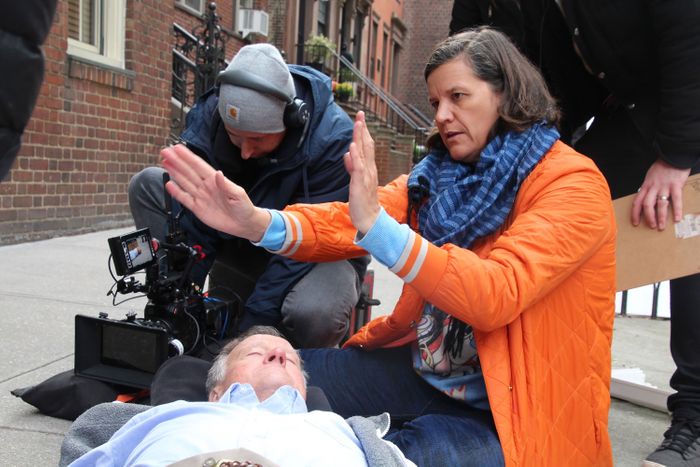
Even in a mask, Kirsten Johnson glows like a lighthouse. She walks like one, too: tall and broad-shouldered, her attention sweeping around like a searchlight. “I think of images as relationships, right?” the director says as we wander through Washington Square Park. For 30 years, she has been making films, and that mode doesn’t just switch off. “There’s a thing of the physical proximity you need in order to film something. I could film that man from all the way over here with a telephoto lens and see him close up,” she says, pointing to someone on a bench in the distance. “But the image betrays it is not an intimate relationship. The image will be true if I am sitting next to him.”
The truth of an image is the core of Johnson’s craft. Before she was celebrated as a director, she worked as a cinematographer on more than 50 documentaries, many of them investigations into racial injustice, gender violence, and the shadow of war. Her long and award-winning collaboration with Laura Poitras resulted in such movies as The Oath and Citizenfour. She filmed sections of Fahrenheit 9/11; she filmed activists in Pray the Devil Back to Hell, an account of the Liberian women’s movement to end the country’s civil war. She shot harrowing footage about weaponized rape in the Balkans for PBS’s Women, War & Peace. She has taken her camera into courtrooms and Army bases and hospital rooms and conflict zones.
In all those documentaries, Johnson’s signature has been her warmth. You can sense it onscreen without seeing her: It’s in what she draws out of people and also in her intoxicating sense of courage, in how close, physically and emotionally, she’s willing to get. Wellington Bowler, who recorded sound on many of her films, calls her “one of the best listeners I have ever worked with.” Poitras thinks the key is Johnson’s “radical sense of presence.” I can attest that there’s something a little dangerous, too — even on a quiet park bench — in the way she moves swiftly past the shallow parts of a conversation. In her wild, rueful new film, Dick Johnson Is Dead, she turns that penetrating eye on her own family. After decades of her sober vérité filmmaking, the movie is a huge aesthetic swing, a hybrid of documentary and trippy dream-logic fiction about the end of her father’s life; he was diagnosed with dementia in 2016. The film, which arrives on Netflix in October, had a warm reception at Sundance, where it won the Special Jury Award for Innovation in Nonfiction Storytelling
When Dick Johnson, a now-retired Seattle psychiatrist and verified pistol, started double-booking appointments and drove through a construction zone, his daughter asked him to leave the West Coast and move in with her and her two children in New York — to make a movie about his death done as a Monty Python–style gag. “The idea was I’m going to kill him over and over,” she says. He was delighted: On film, at least, he can resurrect. In the movie, the crew drop air conditioners on Dick (his stuntman takes the Styrofoam blow), stage slapstick accidents, and show him getting creamed by a car. The director’s children contributed ideas too. “Four-year-olds talking about the ways they’re going to ‘kill Grandpa’ made for some hilarious dinner conversations,” Johnson says. “In the process, I’m teaching my kids that his death is coming. ‘We are about to lose him. We are losing him.’ ” Johnson’s mother died in 2007 after a seven-year struggle with Alzheimer’s, and this time, she wanted to achieve a kind of detachment that wasn’t abandonment. So the movie became both radically honest and totally fantastical, a way to stay close to a beloved father as he slipped away and to derail the “anticipatory grieving” Johnson had gone through for her mother.
Johnson’s response to difficulty has always been to go hard, fast. She pivots more quickly than other people — Poitras notes her ability to work on several different projects simultaneously, each one emotionally excruciating. The moment her mother died, Johnson realized in a lightning flash that she too needed to have children, so at 41, she decided to work out how to do it on her own. At a party in 2008, Johnson had a conversation with documentarian Ira Sachs and his now-husband, Boris Torres, about wanting to have a child. Would she think about teaming up? “I was terrified,” Johnson says. “I was like, I’m gonna try to have children with people I don’t know? Like, we had met once.” She said “Yes.” Her twins are now 8 years old. When the kids were 5, she was sideswiped by her feelings for Tabitha Jackson, who was recently named the head of the Sundance Film Festival. “I didn’t even realize I was falling in love, because I had never been in love with a woman before,” Johnson says. “It was outside of my system of possible constructs. But at a certain point, I was just like, Oh man, what am I gonna do? I had the image of like [she puts up her knuckles like Robert Mitchum showing his tattoos in The Night of the Hunter] FEAR and LOVE. I have conceived of myself as a straight person my entire life!” Another quick pivot: She and Jackson married in January on the first day of Sundance.
In pre-pandemic times, Johnson lived next door to Sachs and Torres in a one-bedroom apartment on Fifth Avenue. The children divided their week between the two homes, and Dick was tucked in on the couch in the living room. In the pandemic, those careful compartmentalizations have collapsed. When I saw her, she was in New York for the day from Connecticut, where she, Jackson, the children, Sachs, and Torres are all staying in a borrowed house together. Dick is in a dementia facility now, and the choice to take him there remains painful. Johnson didn’t want to risk the children giving him COVID-19, but he’s still flickeringly himself, which makes the separation even more difficult. In the park, Johnson FaceTimed him. “Hi, sweetie,” he said. He talked about watching The Price Is Right with the other residents. “I’m glad you’re not calling them ‘inmates’ anymore,” Johnson said, laughing. When we talked about the film, he beamed with pride at his daughter. Before the shutdown, Dick was well enough to travel to Sundance. The film is now like a time machine. For a man who doesn’t remember his past, a recording is a tether; for those of us who refuse to think about our own parents’ decline, Johnson is sending us messages from the future about how goofy and normal and inevitable this kind of heartbreak is.
After decades of Johnson’s restrained documentary work, Dick Johnson Is Dead is unabashedly stunty, sometimes blurring the line between what’s true and what’s not. The result is a little Harold and Maude, a little Still Alice, and a little terrifying. The absence of pity can sometimes be startling, especially when you see the documentarian’s dispassion trained on a tottering old man. “Humor is really tricky,” says Johnson. “It’s a little mean.” There’s a vein of emotional perversity in Dick Johnson Is Dead. Dick’s best friend in Seattle is caught on-camera sobbing uncontrollably after being made to picture his dear friend’s death. In talking about it, I realize there are moments in the film that Johnson and I see differently. An interview with her father’s health aide, for instance, in which the nurse talks frankly about the film, strikes Johnson as an affirming interlude. But the woman seems troubled, and when she says, frowning, “He loves you; he’d do anything for you,” I don’t hear it as a sanction for the movie.
Her editor and co-writer, Nels Bangerter, says the key to accepting the film is “the way she has been as a person.” Johnson seems impervious to fear, but she’s palpably caring and nearly obsessive when it comes to the ethics of her work. You may need to know those things to fully relax into the moral complexity of Dick Johnson Is Dead. Only she could “pull off this crazy thing that is borderline ‘Where are the ethics of this?’ ” says Bangerter.
Several years ago, when Johnson was three years into directing a feature in Afghanistan, her subject — a girl whose testimony would have put her own life in danger — withdrew from the film after shooting had finished. The project, now out of money, went into crisis. Johnson and her producers turned sharply; she got permission to use film from dozens of documentaries she had shot over the years, then cut the footage together into a stunning collage, like a Koyaanisqatsi for war zones. The result is her 2016 masterpiece, Cameraperson. The film asks serious questions about agency and responsibility, about the role of the visiting witness who gathers up tragedy and then moves on. What does looking really do? The camera doesn’t flinch, but it teaches the viewer to flinch, to wonder about the violations and swift intimacies inherent in making these documentaries. We hear translators in Bosnia talking about the trauma they’ve taken on by helping documentarians interview victims; we sense the danger that trails behind the eager American asking questions. The film is ravishing and loving but self-laceratingly moral. All the thorny questions Cameraperson raises show up again in Dick Johnson Is Dead. The films work in conversation. In diptych, the former movie tells you what sort of person is behind the camera; the latter one shows you what that gives her the capacity to do.
A few weeks ago, Johnson dreamed she was in a house and discovered an extra room. How surprising! How delightful! But this time, doorways kept opening into different spaces. Open one door, and it’s the ocean. Open the next, a desert. In each room, she kept finding her father. In one of them, he was in a room that seemed bare and empty. “Dad,” she remembers asking him, “what are you doing in this room? You’re missing all your things.”
Johnson’s dreams are detailed and complete and in Technicolor. Much of the wild maximalism in Dick Johnson is deliberately dreamlike. One shot she was hoping to get, early in her planning of the shoot, was of her father drifting out to sea on an ice floe, an archetypal image of surrender to the deep. But his dementia was advancing faster than the production schedule could keep up with, so the film had to adapt. “The ice floe was transformed into a white square in the studio,” Johnson says, so they could use special effects instead. But even that was proving beyond Dick’s waning capacities. “I didn’t know what would happen if he walked onto it by himself,” she remembers. “I actually don’t know if it’s safe to do. Would he tip over and hurt himself? That’s the stage he was at. I just lost it. I was weeping in front of the entire crew.”
The “detachment without abandonment” project has only been partially successful. Sometimes, Johnson falters. As much as Dick Johnson is about her father, it’s autobiographical. It seesaws along with her own mind. “The idea of my father’s dying is terrifying, heartbreaking,” she says. “But the idea of it is a relief. I wish him to die; I don’t wish him to die. Am I exploiting him with this film? Am I giving him immortality?”
“What I’m trying to do is accompany my father to the edge of this cliff, right?” she continues. “At some unexpected moment, he’s going to drop off the cliff and then he’s gone. When we got him to this home, I was like, Okay, new metaphor. We’ve walked along the cliff; he fell off the cliff. But he’s only fallen five feet down. He’s hanging by a branch.” At the facility, she recalls him begging her to take him back. “I am standing at the top of the cliff, looking at my father five feet down holding on to a branch. And I’m saying, ‘I can’t come get you. You’ve got to stay there.’ It’s like, Are you kidding? No human should have to do this. And yet this is what humans have to do, right? At a certain point, you have to stay at the top of the cliff.”
*This article appears in the September 28, 2020, issue of New York Magazine. Subscribe Now!






